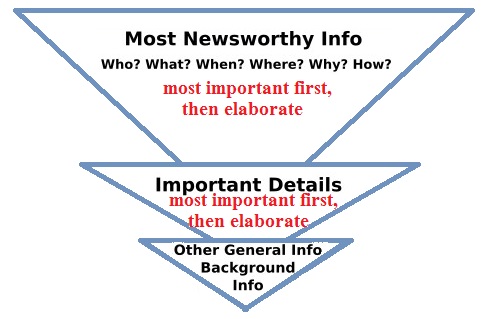You have already dealt with the five Ws. You know that if you can answer these five questions about your news subject, you have all you need to write a piece of news.
Who? What? When? Where? Why? The most interesting of these is “Why,” but it’s not the journalist’s job to say why. An expert or authority says why, and a journalist provides information to the reader about who, what, when and where. The journalist can also inform the reader on the why by providing further backstory and other contextual information. If a journalist lets the reader know how the journalist feels, the journalist has crossed a line, and the article has become an opinion piece.
Let’s move on.
As you continue to develop your piece of news, remember: news is written most important (or newsworthy) information first.
The most important paragraph is first, followed by the second. And within a paragraph, the most important information is first, followed by other information on the same point.
A concept in journalism that expresses this idea is the “inverted pyramid.”
 After the first few paragraphs the formula is less important. By the time a reader has reached about the fourth paragraph, he or she will know what the article is about, and will read further if he or she is so inclined. At that point, the reader will probably be interested in reading a good story.
After the first few paragraphs the formula is less important. By the time a reader has reached about the fourth paragraph, he or she will know what the article is about, and will read further if he or she is so inclined. At that point, the reader will probably be interested in reading a good story.
That said, a journalist may still wish to continue writing along the lines of an inverted pyramid of inverted pyramids to conclusion.
by The Speaker